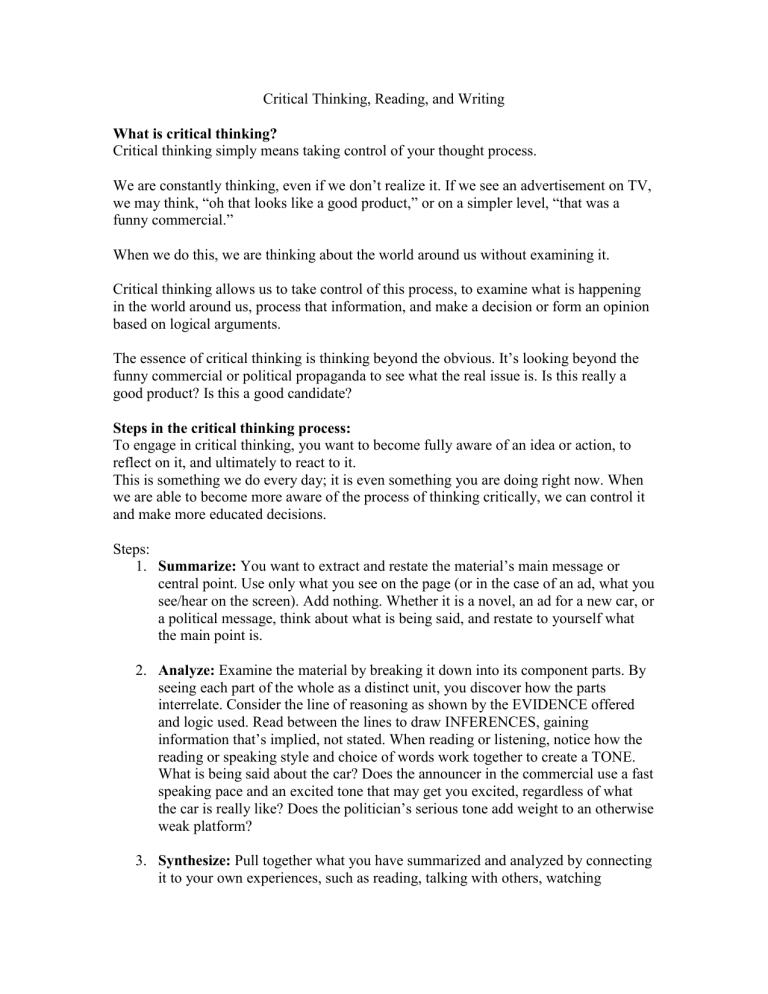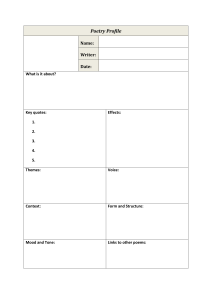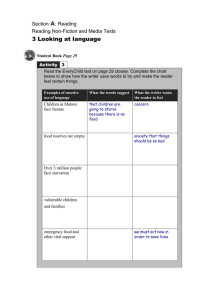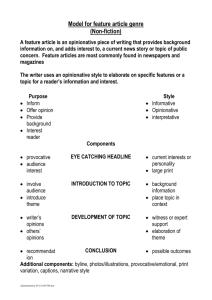
Critical Thinking, Reading, and Writing What is critical thinking? Critical thinking simply means taking control of your thought process. We are constantly thinking, even if we don’t realize it. If we see an advertisement on TV, we may think, “oh that looks like a good product,” or on a simpler level, “that was a funny commercial.” When we do this, we are thinking about the world around us without examining it. Critical thinking allows us to take control of this process, to examine what is happening in the world around us, process that information, and make a decision or form an opinion based on logical arguments. The essence of critical thinking is thinking beyond the obvious. It’s looking beyond the funny commercial or political propaganda to see what the real issue is. Is this really a good product? Is this a good candidate? Steps in the critical thinking process: To engage in critical thinking, you want to become fully aware of an idea or action, to reflect on it, and ultimately to react to it. This is something we do every day; it is even something you are doing right now. When we are able to become more aware of the process of thinking critically, we can control it and make more educated decisions. Steps: 1. Summarize: You want to extract and restate the material’s main message or central point. Use only what you see on the page (or in the case of an ad, what you see/hear on the screen). Add nothing. Whether it is a novel, an ad for a new car, or a political message, think about what is being said, and restate to yourself what the main point is. 2. Analyze: Examine the material by breaking it down into its component parts. By seeing each part of the whole as a distinct unit, you discover how the parts interrelate. Consider the line of reasoning as shown by the EVIDENCE offered and logic used. Read between the lines to draw INFERENCES, gaining information that’s implied, not stated. When reading or listening, notice how the reading or speaking style and choice of words work together to create a TONE. What is being said about the car? Does the announcer in the commercial use a fast speaking pace and an excited tone that may get you excited, regardless of what the car is really like? Does the politician’s serious tone add weight to an otherwise weak platform? 3. Synthesize: Pull together what you have summarized and analyzed by connecting it to your own experiences, such as reading, talking with others, watching television and films, using the internet and so on. By doing this, you create a new whole, based on the information you have gathered, and the knowledge of the world you have already gained through experience. 4. Evaluate: Judge the quality of the material now that you have become informed through the first three steps. Resist the very common urge to evaluate before you engage in these steps. What is the reading process? It is important to be familiar with the steps in the reading process, so as writers, we know what our audience will be looking for, and what they will expect of us. Reading is an active process. If you are a passive reader, then you are not gaining anything from what you have read. You have simply taken in a lot of information which may or may not be useful. Understanding the reading process as an active process, that as readers we should take control of, can help you become a better critical reader. The critical reading process involves your thinking on 3 levels: 1. Reading for literal meaning: This is simply reading for comprehension. You are looking for the main ideas, the supporting details and making sure you understand them. If you take Composition II, you will be reading literature critically. This will involve looking to make sure you understand the central ideas of plot and character. What is going on in the story? 2. Reading to draw inferences: This is reading to understand what is suggested or implied, but not stated. Many times, the author will not come right out and tell you what you are supposed to get out of a work. If we simply read for a literal meaning, we may miss the point the author is trying to make. There are some things you can look for when reading to help signal what you should be inferring: a. Is the tone of the material appropriate? Tone can affect your writing in several different ways, including meaning. Look for tones that are highly emotional, sarcastic, cautious. If you notice these, they may be an attempt by the writer to manipulate you as a reader. b. Can you detect a prejudice or bias in the material? In writing, it is ok for an author to have an opinion and to try to convince readers to think like them by presenting the material in a way which best supports their opinion. However, when material becomes distorted by hatred or dislike for (or alternately by an extreme like or devotion to) individuals, groups, or ideas, you want to suspect the accuracy and fairness of what is being presented. Don’t let the author’s personal convictions get in the way of your understanding of the issues. Make sure the information stands on a strong foundation. Otherwise, the writer may be inferring a prejudice or bias. c. Is there a clear separation between fact and opinion? Facts can be verified; opinions are statements of personal belief. Some writers will try to blur the line between these two and present their opinions in a way that sounds like they are based in fact. So read to be sure you are not being fooled by this. Are opinions ok? Yes, as long as they are not presented as fact. 3. Reading to Evaluate: When doing this, you are judging the writer’s work. Now you are taking an overall assessment of the writer’s reasoning (are their arguments logical?), evidence (have they provided enough concrete support?), word choice, and the writer’s respect for the reader (are they talking down to or above the heads of their audience.



